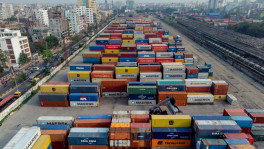Our farmlands are disappearing fast. Compact housing can be a solution
Bangladesh’s food security is being threatened as croplands continue to shrink due to the unplanned expansion of rural settlements. The Business Standard recently talked to Dr Akter Mahmud, Professor, Department of Urban and Regional Planning at Jahangirnagar University to discuss the way out of this precarious situation

Senior upazila master plan specialist at Technical Assistance Project for My Village-My Town Dr Akter Mahmud, a professor of urban and regional planning at Jahangirnagar University, recently wrote about compact housing and land readjustment to conserve agricultural land and the environment in a Bangla daily.
According to Dr Mahmud, who is also a former president of the Bangladesh Institute of Planners, the precious cropland will no longer exist if the unplanned expansion of rural settlements cannot be stopped. Negligence in land management will threaten Bangladesh's food security.
The Business Standard recently caught up with the rural planner to know more.
How do you define the trend of land loss, particularly around rural Bangladesh?
Bangladesh is a small country housing a vast population. Several studies suggest that Bangladesh's population density is more than 1,200 per square kilometre, and many European cities have a much lower population than Bangladeshi cities.
We have to realise that farmland is a precious resource of the country, and nothing else can compensate for it. If a piece of cropland gets converted into a non-agricultural piece of land, it will remain so permanently.
A grave concern is that the cropland and the natural ecosystem have been disappearing. What are the reasons?
First, rural housing settlements are expanding. A housing plot owned by one person is divided into multiple pieces by the heirs, resulting in more new houses being built by the next generation. We are in a continuous process of gobbling up cropland.
In addition, infrastructural development and industrialisation are also responsible for the reduction of agricultural land.
We are losing our wetlands which are integral parts of our ecosystem, and our forests are disappearing due to rapid urbanisation.
There are study findings that between 1961 and now, per capita land for agriculture has dropped to 0.048 hectares.
We must protect our agricultural land. We should try to bring the rural settlements under a compact housing practice, and for that, the country needs a National Physical Plan.
What is compact housing? Where did the concept originate from?
Dr Salim Rashid, an Emeritus Professor of economics at the University of Illinois, introduced the concept of compact housing two decades back. His idea is still at the theoretical level. Echoing Professor Salim, I also recommend piloting a compact housing project.
How could it be done? See, many people in rural areas live on non-agricultural jobs at present. Many successors of farmers have not inherited the profession, and they either work in RMG and other industrial sectors or work overseas.
Many remittance providers have come from rural areas. Their family members still live in villages.
People like them no longer prefer to live in agrarian housing facilities. They require the security of their life and property, and compact housing will provide them with a healthy life and safety.

What is compact housing?
Compact housing is an agglomeration of houses, hospitals, schools, markets, rural industries and local governmental units that provide all essential services to a threshold population — ensuring the best use of land.
It might be plot-based or low-rise apartment-based. There would be a shared space like a community park or playground, and well-planned roads would connect the whole area.
When rural settlements evolve haphazardly, providing utilities like power connection and water supply becomes very challenging.
On the other hand, providing most civic services–at affordable prices and accessible ways–can be made possible for the people who reside in a compact housing system. In such well-planned places, waste management can be done easily.
Suppose a threshold population (the minimum number of people needed for a service to be practical) is set in the area. In that case, they can establish a primary school, a doctors' chamber and other facilities there.
Public services become easy to provide if there is compact housing. For example, when a compact housing has a mini health facility, pressure on Upazila Health Complex reduces.
Consequently, we can conserve our agricultural land by controlling the expansion of rural settlements.
In the past, many people rehabilitated to the Ashrayan Project did not find the cluster housing comfortable because of the non-agrarian arrangement. For example, there was no courtyard. Do you think that rural people will accept the idea of compact housing?
Right. The ecological needs of the rural families requiring a courtyard and places for rearing poultry and cattle are different as they are agriculture-dependent.
As I mentioned earlier, there are non-agrarian families too living in the rural places. Only 40% of the rural people are involved in agriculture, and the sector contributes only 15% of the total GDP.
If there is well-planned compact housing for such people, there will be a school, a park, a well-managed waterbody, and a place for social gatherings. People under compact housing will have a good standard of living.
We may consider another thing. If the rural settlements under a compact housing facility are designed to be compatible with rural ecology, families can rear poultry and cattle in their houses. Architects and civil engineers have already developed such designs, and we need to accumulate these ideas.
Recently, you recommended that rural landowners develop a planned residential area by private arrangement. Since the people are dependent on government initiatives, how can such an arrangement be possible privately?
Individuals cannot get organised by themselves. Upazila administration and grassroots representatives must be involved in this process. They can organise the landowners and implement the plan in a cooperative style. A land management committee can be formed. The Local Government Engineering Department and Bangladesh Institute of Planners can provide them with technical assistance.
At the Upazila level, there is a crying need for an Upazila-wise Master Plan. Upazila Parishads will need planners to implement the plan after it is formulated. Otherwise, none can implement the plan, and the land management will not be done properly. Currently, there are officers in civil engineering, health, education and agriculture departments at the upazila level. There should be planners as well.
Why is land readjustment important? What are the steps of land readjustment?
There are several techniques and steps of land readjustment.
For example, landowners will first hand over their lands temporarily to the cooperative they have formed, and it will consolidate the land properties.
The second step is to draw up a plan. The plan should cover road communications, utility networks and plots for residential, educational, recreational, cultural and other required facilities.
As the landowners will get access to a higher standard of living in turn, they will not be able to access the exact amount of land for individual use that they handed over to the cooperative.
For example, they will get 50% of the original land for individual use. In return, they will get civic amenities and a better environment to live in. 30% of the land will be dedicated to road communication and utility networks. And the rest of the land will be 'reserved' for commercial plots. The cooperative can manage the project costs with the revenue earned by selling the commercial plots to outsiders.
Should there be a law to make such land readjustments popular?
Yes, indeed. The Agricultural Land Protection and Land Use Act was finalised in 2015. But the government has not approved the law yet.
However, even though the law was formulated to protect the croplands, it does not cover the land readjustment issue. So, there should be a separate law for land readjustment.


 Keep updated, follow The Business Standard's Google news channel
Keep updated, follow The Business Standard's Google news channel
















